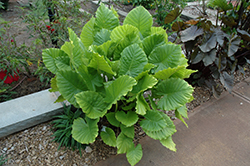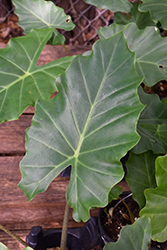Fri & Sat 8am - 8pm
Sun 8am - 7pm
Anytown, USA 12345
fax: 261.787.0463
e-mail: info@successgc.com


Plant Finder

Height: 6 feet
Spread: 5 feet
Sunlight:
![]()
![]()
Other Names: Elephant's Ear, Alocasia, Taro
Group/Class: Leafjoy Houseplants
Brand: Proven Winners
Description:
Enormous, scalloped leaves pointing straight upward on strong, sturdy stalks; can reach up to 8 feet outdoors, but smaller indoors; very elegant as a large accent or screen in a bright indoor space
Features & Attributes
Mythic™ Portora Elephant Ears' attractive enormous crinkled pointy leaves emerge light green, turning bluish-green in color throughout the year on a plant with an upright spreading habit of growth.
This is an open herbaceous evergreen houseplant with an upright spreading habit of growth. This plant usually looks its best without pruning, although it will tolerate pruning.
Planting & Growing
When grown indoors, Mythic™ Portora Elephant Ears can be expected to grow to be about 6 feet tall at maturity, with a spread of 5 feet. It grows at a medium rate, and under ideal conditions can be expected to live for approximately 5 years. This houseplant will do well in a location that gets either direct or indirect sunlight, although it will usually require a more brightly-lit environment than what artificial indoor lighting alone can provide. It prefers to grow in average to moist soil. The surface of the soil shouldn't be allowed to dry out completely, and so you should expect to water this plant once and possibly even twice each week. Be aware that your particular watering schedule may vary depending on its location in the room, the pot size, plant size and other conditions; if in doubt, ask one of our experts in the store for advice. It will benefit from a regular feeding with a general-purpose fertilizer with every second or third watering. It is not particular as to soil pH, but grows best in rich soil. Contact the store for specific recommendations on pre-mixed potting soil for this plant. Be warned that parts of this plant are known to be toxic to humans and animals, so special care should be exercised if growing it around children and pets.
There are many factors that will affect the ultimate height, spread and overall performance of a plant when grown indoors; among them, the size of the pot it's growing in, the amount of light it receives, watering frequency, the pruning regimen and repotting schedule. Use the information described here as a guideline only; individual performance can and will vary. Please contact the store to speak with one of our experts if you are interested in further details concerning recommendations on pot size, watering, pruning, repotting, etc.
-- THIS IS A HOUSEPLANT AND IS NOT MEANT TO SURVIVE THE WINTER OUTDOORS IN OUR CLIMATE --

